Counting SortIt is a linear time sorting algorithm which works faster by not making a comparison. It assumes that the number to be sorted is in range 1 to k where k is small. Basic idea is to determine the "rank" of each number in the final sorted array. Counting Sort uses three arrays:
Firstly C [x] to be a number of elements of A [j] that is equal to x
We set B[C [x]] =A[j] If there are duplicates, we decrement C [i] after copying. Explanation: Step1: for loop initialize the array R to 'o'. But there is a contradict in the first step initialize of loop variable 1 to k or 0 to k. As 0&1 are based on the minimum value comes in array A (input array). Basically, we start I with the value which is minimum in input array 'A' For loops of steps 3 to 4 inspects each input element. If the value of an input element is 'i', we increment C [i]. Thus, after step 5, C [i] holds the number of input element equal to I for each integer i=0, 1, 2.....k Step 6 to 8 for loop determines for each i=0, 1.....how many input elements are less than or equal to i For loop of step 9 to 11 place each element A [j] into its correct sorted position in the output array B. for each A [j],the value C [A[j]] is the correct final position of A [j] in the output array B, since there are C [A[j]] element less than or equal to A [i]. Because element might not be distinct, so we decrement C[A[j] each time we place a value A [j] into array B decrement C[A[j] causes the next input element with a value equal to A [j], to go to the position immediately before A [j] in the output array. Analysis of Running Time:
Overall time is θ(k+n) time. Note:
Example: Illustration the operation of Counting Sort in the array. Solution: 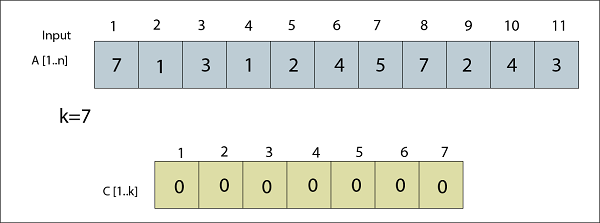
Fig: Initial A and C Arrays 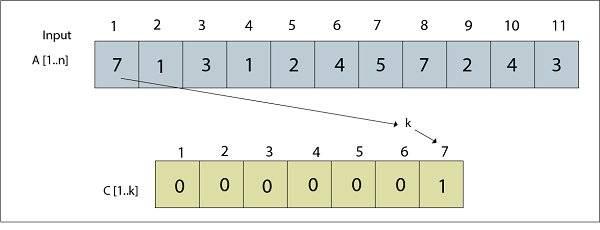
Fig: A [1] = 7 Processed 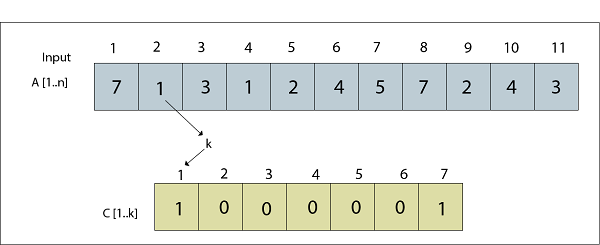
Fig: A [2] = 1 Processed 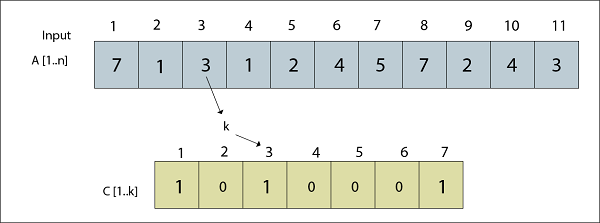
Fig: A [3] = 3 Processed 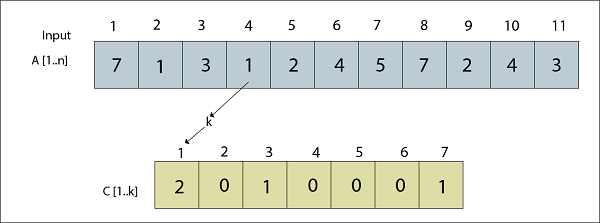
Fig: A [4] = 1 Processed 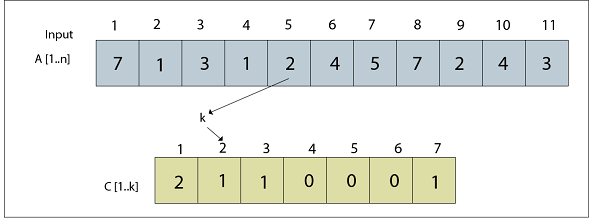
Fig: A [5] = 2 Processed UPDATED C is: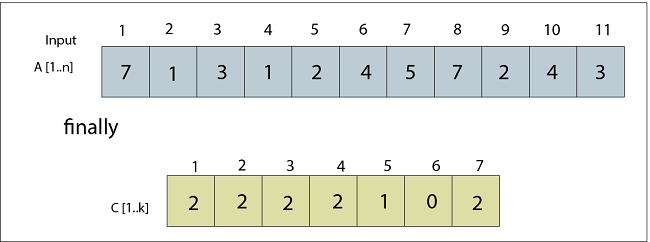
Fig: C now contains a count of elements of A Note: here the item of 'A' one by one get scanned and will become a position in 'C' and how many times the item get accessed will be mentioned in an item in 'C' Array and it gets updated or counter increased by 1 if any item gets accessed again.Now, the for loop i= 2 to 7 will be executed having statement: By applying these conditions we will get C updated as i stated from 2 up to 7 C [2] = C [2] + C [1] C [3] = C [3] + C [2] C [2] = 2 + 2 C [3] = 2 + 4 C [2] = 4 C [3] = 6 C [4] = C [4] + C [3] C [5] = C [5] + C [4] C [4] = 2 + 6 C [5] = 1 +8 C [4] = 8 C [5] = 9 C [6] = C [6] + C [5] C [7] = C [7] + C [6] C [6] = 0 + 9 C [7] = 2 + 9 C [6] = 9 C [7] = 11 Thus the Updated C is: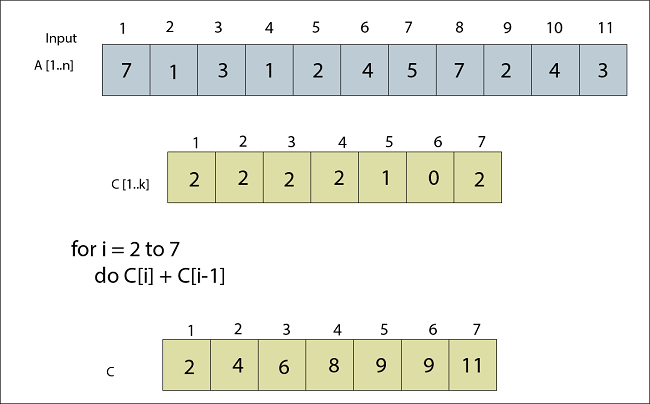
Fig: C set to rank each number of A Now, we will find the new array B 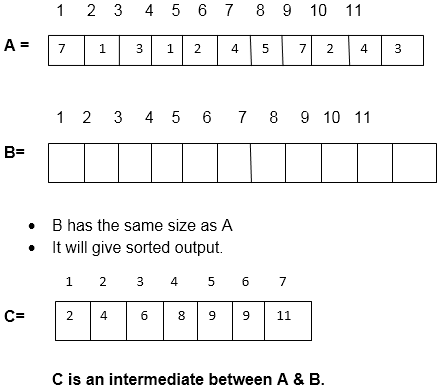
Now two Conditions will apply:
We decrease counter one by one by '1' Step 1B [C [A [11]]] = A [11] C [A [11] = C [A [11]-1 B [C [3] = 3 C [3] = C [3] -1 B [6] = 3 C [3] = 5 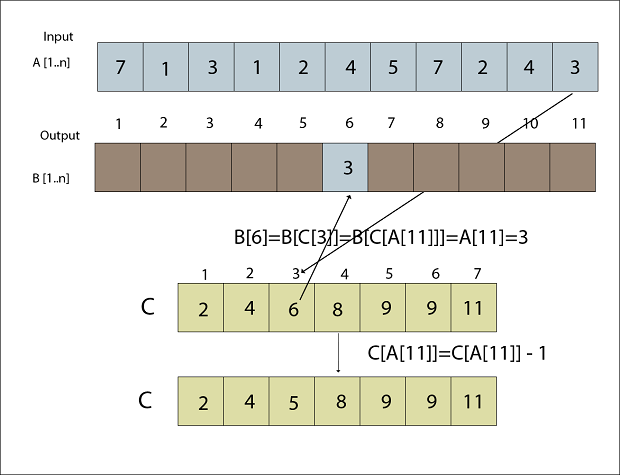
Fig: A [11] placed in Output array B Step 2B [C [A [10]]] = A [10] C [A [10]] = C [A [10]]-1 B [C [4]] =4 C [4] = C [4] -1 B [8] = 4 C [4] = 7 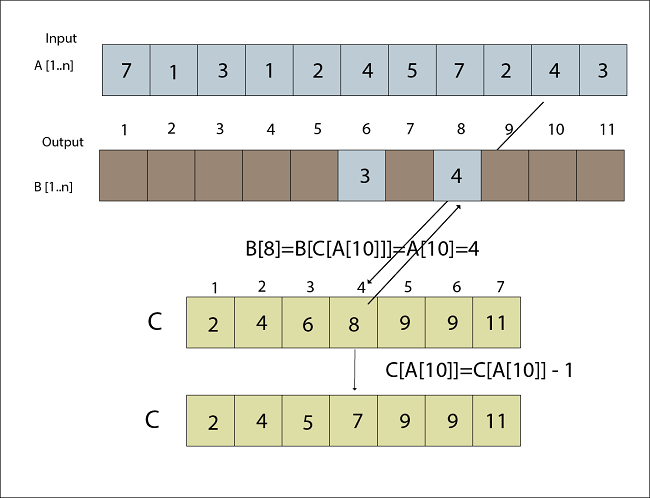
Fig: A [10] placed in Output array B Step 3B [C [A [9]] = A [9] C [A [9] = C [A [9]]-1 B [C [2]] = A [2] C [2] = C [2]-1 B [4] = 2 C [2] = 3 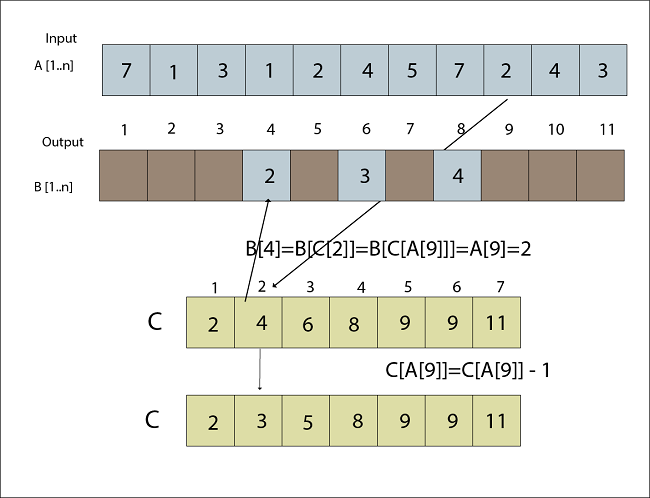
Fig: A [9] placed in Output array B Step 4B [C [A [8]]] = A [8] C [A [8]] =C [A [8]] -1 B [C [7]] =7 C [A [8]] = C [7]-1 B [11] =7 C [7] = 10 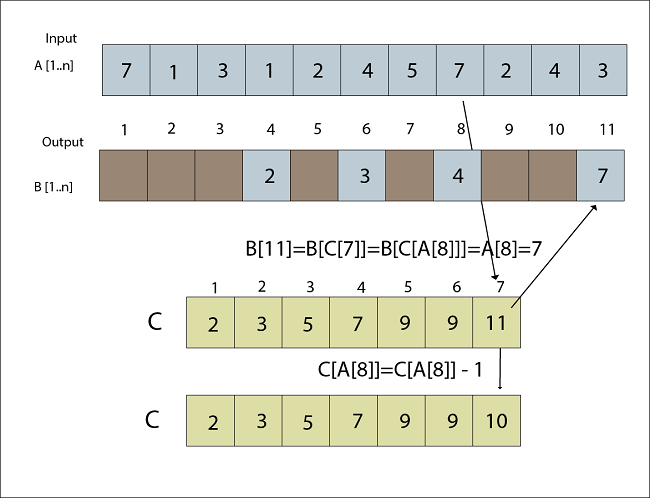
Fig: A [8] placed in Output array B Step 5B [C [A [7]]] = A [7] C [A [7]] = C [A [7]] - 1 B [C [5]] = 5 C [5] = C [5] - 1 B [9] = 5 C [5] =8 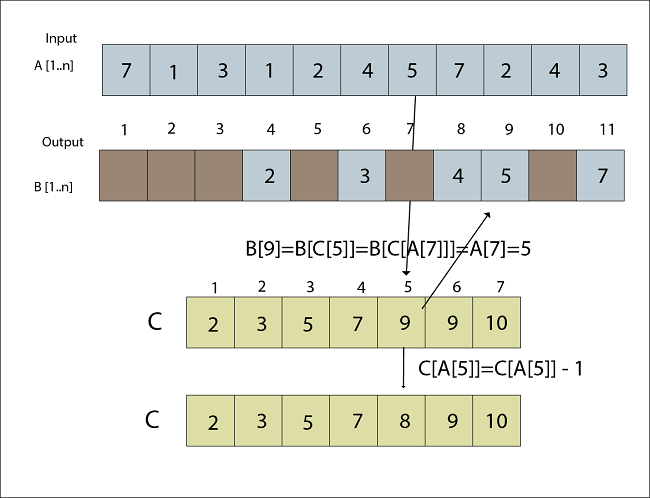
Fig: A [7] placed in Output array B Step 6B [C [A [6]]] = A [6] C [A [6]] = C [A [6]] - 1 B [C [4]] = 4 C [4] = C [4] - 1 B [7] = 4 C [4] = 6 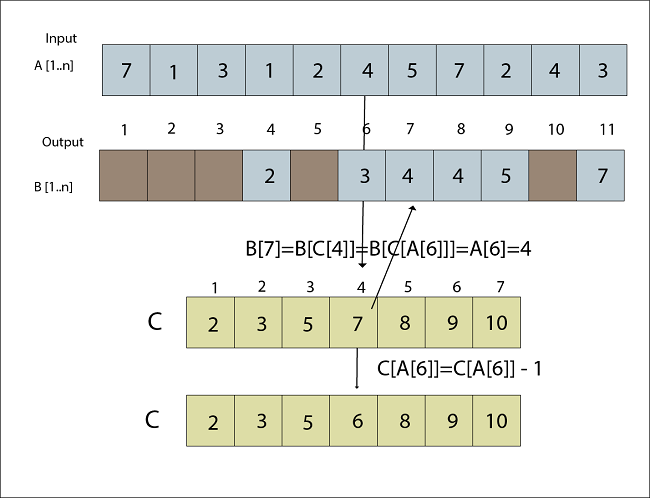
Fig: A [6] placed in Output array B Step 7B [C [A [5]]] = A [5] C [A [5] = C [A [5]] -1 B [C [2] =2 C [2] = C [2] - 1 B [3] = 2 C [2] = 2 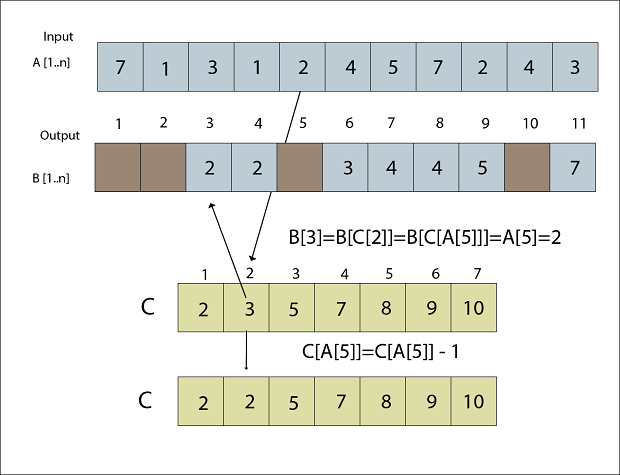
Fig: A [5] placed in Output array B Step 8B [C [A [4]]] = A [4] C [A [4]] = C [A [4]] - 1 B [C [1] = 1 C [1] = C [1] - 1 B [2] = 1 C [1] = 1 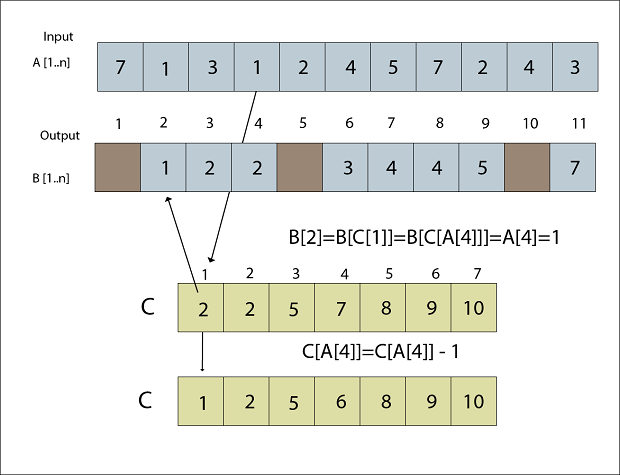
Fig: A [4] placed in Output array B Step 9B [C [A [3]]] = A [3] C [A [3]] = C [A [3]] - 1 B [C [3] = 3 C [3] = C [3] - 1 B [5] = 3 C [3] = 4 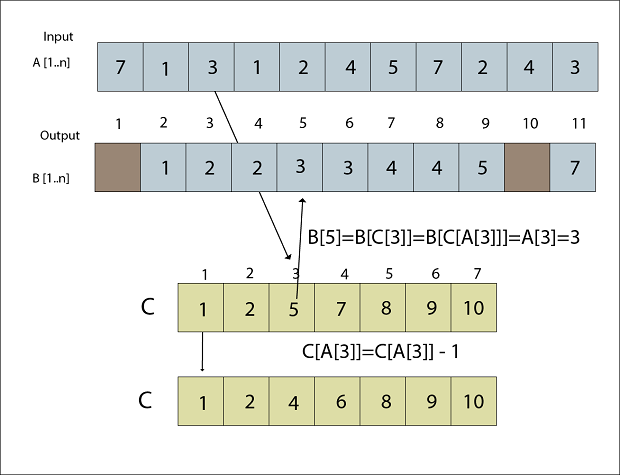
Fig: A [3] placed in Output array B Step 10B [C [A [2]]] = A [2] C [A [2]] = C [A [2]] - 1 B [C [1]] = 1 C [1] = C [1] - 1 B [1] = 1 C [1] = 0 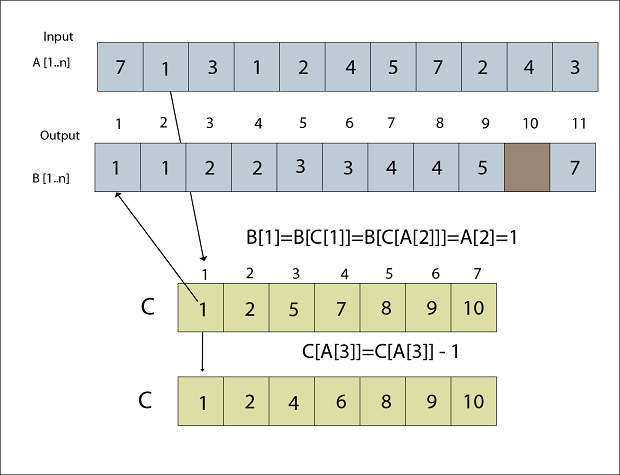
Fig: A [2] placed in Output array B Step 11B [C [A [1]]] = A [1] C [A [1]] = C [A [1]] - 1 B [C [7]] = 7 C [7] = C [7] - 1 B [10] = 7 C [7] = 9 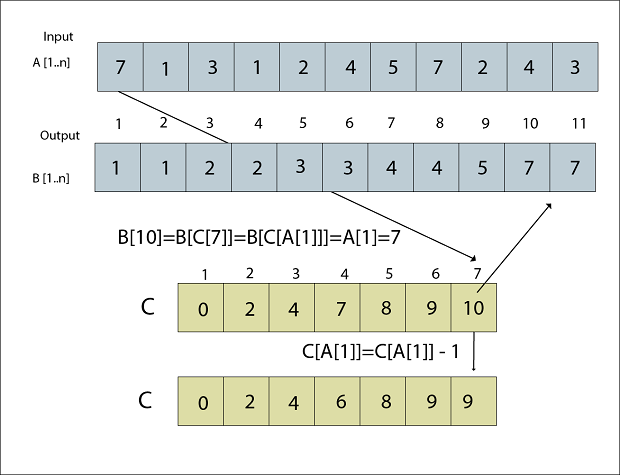
Fig: B now contains the final sorted data.
Next TopicBucket Sort
|
 For Videos Join Our Youtube Channel: Join Now
For Videos Join Our Youtube Channel: Join Now
Feedback
- Send your Feedback to [email protected]
Help Others, Please Share










